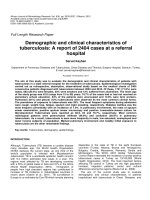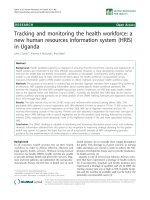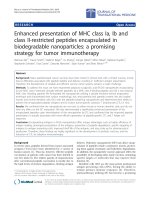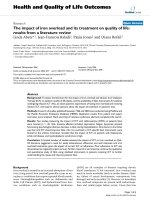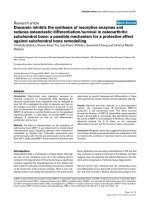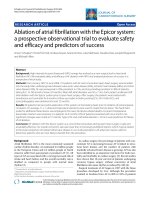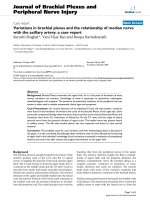ELECTROCHEMICAL MACHINING (ECM)
Bạn đang xem bản rút gọn của tài liệu. Xem và tải ngay bản đầy đủ của tài liệu tại đây (479.1 KB, 19 trang )
<span class='text_page_counter'>(1)</span><div class='page_container' data-page=1>
<b>ELECTROCHEMICAL MACHINING (ECM) </b>
<i>Joseph McGeough</i>
<i>Institute for Integrated Micro and Nano Systems</i>
<i>University of Edinburgh</i>
<i>Edinburgh, EH9 3JL, United Kingdom</i>
(July, 2005)
Michael Faraday�s early metallurgic researches, from 1818 to 1824, anticipated the
developments which have led to widespread use today of alloy steels. Much effort has
been expended to improve their performance for their service as cutting tools in
machining. The aim has always been to yield higher rates of machining and to tackle
recently developed harder materials on the principle that the tool material must be harder
than the workpiece which is to be machined. Much progress has been made; however, in
recent years some alloys, which are exceedingly difficult to machine by the conventional
methods, have been produced to meet a demand for very high-strength, heat resistant
materials. Moreover, these new materials often have to take a complex shape. A search
has had to be made for alternative methods of machining since the evolution of suitable
tooling has not kept pace with these advances.
Electrochemical machining (ECM) has been developed initially to machine these hard to
machine alloys, although any metal can so be machined. ECM is an electrolytic process
and its basis is the phenomenon of electrolysis, whose laws were established by Faraday
in 1833. The first significant developments occurred in the 1950s, when ECM was
investigated as a method for shaping high strength alloys. As of the 1990s, ECM is
employed in many ways, for example, by automotive, offshore petroleum, and medical
engineering industries, as well as by aerospace firms, which are its principal user.
Metal removal is achieved by electrochemical dissolution of an anodicallypolarized
workpiece which is one part of an electrolytic cell in ECM. Hard metals can be shaped
electrolytically by using ECM and the rate of machining does not depend on their
hardness. The tool electrode used in the process does not wear, and therefore soft metals
can be used as tools to form shapes on harder workpieces, unlike conventional machining
methods. The process is used to smooth surfaces, drill holes, form complex shapes, and
remove fatigue cracks in steel structures. Its combination with other techniques yields
fresh applications in diverse industries. Recent advances lie in computer-aided tool
design, and the use of pulsed power, which has led to greater accuracy for
ECM-produced components.
<b>Theoretical background</b>
Since electrolysis is the basis of ECM, it must be understood before going further through
the characteristics and other details of the process.
</div>
<span class='text_page_counter'>(2)</span><div class='page_container' data-page=2>
Electrolysis is the name
given to the chemical
process which occurs,
for example, when an
electric current is passed
between two conductors
dipped into a liquid
solution. A typical
example is that of two
copper wires connected
to a source of direct
current and immersed in
a solution of copper
sulphate in water, as
shown in Figure 1. An
ammeter, placed in the
circuit, will register a
flow of current; from
this indication, the
electric circuit can be deduced to be complete. A significant conclusion that can be made
from an experiment of this sort is that the copper sulphate solution obviously has the
property that it could conduct electricity. Such solution is termed an electrolyte. The
wires are called electrodes, the one with positive polarity being the anode, and the one
with negative polarity the cathode. The system of electrodes and electrolyte is referred to
as the electrolytic cell, whilst the chemical reactions which occur at the electrodes are
called the anodic or cathodic reactions or processes.
Electrolytes are different
from metallic conductors
of electricity in that the
current is carried not by
electrons but by atoms,
or group of atoms, which
have either lost or
gained electrons, thus
acquiring either positive
or negative charges.
Such atoms are called
ions. Ions which carry
positive charges move
through the electrolyte in
the direction of the
positive current, that is,
toward the cathode, and
are called cations.
Similarly, the negatively charged ions travel toward the anode and are called anions. The
<i>Fig. 1. Electrolysis of copper sulphate solution. </i>
</div>
<span class='text_page_counter'>(3)</span><div class='page_container' data-page=3>
movement of the ions is accompanied by the flow of electrons, in the opposite sense to
the positive current in the electrolyte, outside the cell, as shown also in Figure 2 and both
reactions are a consequence of the applied potential difference, that is, voltage, from the
electric source.
A cation reaching the cathode is neutralized, or discharged, by the negative electrons on
the cathode. Since the cation is usually the positively charged atom of a metal, the result
of this reaction is the deposition of metal atoms.
To maintain the cathodic reaction, electrons are required to pass around the external
circuit. These are obtained from the atoms of the metal anode, and these atoms thus
become the positively charged cations which pass into solution. In this case, the reaction
is the reverse of the cathodic reaction.
The electrolyte in its bulk must be electrically neutral; that is, there must be equal
numbers of opposite charges within it, and thus there must be equal amounts of reaction
at both electrodes. Therefore, in the electrolysis of copper sulphate solution with copper
electrodes, the overall cell reaction is simply the transfer of copper metal from the anode
to the cathode. When the wires are weighted at the end of the experiment, the anodic wire
will be found to have lost weight, whilst the cathodic wire will have increased in weight
by an amount equal to that lost by the other wire. Some examples of the reactions
occurring in these processes are shown in the Appendix.
These results are embodied in Faraday� s two laws of electrolysis:
1. The amount of any substance dissolved or deposited is directly proportional to the
amount of electricity which has flowed.
2. The amounts of different substances deposited or dissolved by the same quantity
of electricity are proportional to their chemical equivalent weights.
A popular application of electrolysis is the <i>electroplating</i> process in which metal coatings
are deposited upon the surface of a cathodically polarized metal. An example of an
anodic dissolution operation is electropolishing. Here, the item which is to be polished is
made the anode in an electrolytic cell. Irregularities on its surface are dissolved
preferentially so that, on their removal, the surface becomes flat and polished.
ECM is similar to electropolishing in that it also is an anodic dissolution process. But the
rates of metal removal offered by the polishing process are considerably less than those
needed in metal machining practice.
Some observations relevant to ECM can be made:
Since the anode metal dissolves electrochemically, its rate of dissolution depends
</div>
<span class='text_page_counter'>(4)</span><div class='page_container' data-page=4>
Since only hydrogen gas is evolved at the cathode, the shape that electrode
remains unaltered during the electrolysis. This feature is perhaps the most relevant
in the use of ECM as a metal shaping process.
<i><b>Characteristics of ECM</b></i>
In ECM, electrolytes serve as conductors of electricity and Ohm� s law also applies to
this type of conductor. The resistance of electrolytes may amount to hundreds of ohms.
Accumulation within the small machining gap of the metallic and gaseous products of the
electrolysis is undesirable. If growth were left uncontrolled, eventually a short circuit
would occur between the two electrodes. To avoid this crisis, the electrolyte is pumped
through the interelectrode gap so that the products of the electrolysis are carried away.
The forced movement of the electrolyte is also essential in diminishing the effects both of
electrical heating of the electrolyte, resulting from the passage of current and hydrogen
gas, which respectively increase and decrease the effective conductivity.
<i><b>Working principles</b></i>
Electrochemical
machining is founded on
the principles outlined.
As shown in Figure 3,
the workpiece and tool
are the anode and
cathode, respectively, of
an electrolytic cell, and a
constant potential
</div>
<span class='text_page_counter'>(5)</span><div class='page_container' data-page=5>
heating. The rate at which metal is then removed from the anode is approximately in
inverse proportion to the distance between the electrodes. As machining proceeds, and
with the simultaneous movement of the cathode at a typical rate, for example, 0.02
millimeter/second toward the anode, the gap width along the electrode length will
gradually tend to a steady-state value. Under these conditions, a shape, roughly
complementary to that of the cathode, will be reproduced on the anode. A typical gap
width then should be about 0.4 millimeter. Being understood the characteristics and
working principles of ECM, its advantages should be stated in short before going further
through machining processes:
• the rate of metal machining does not depend on the hardness of the material,
• complicated shapes can be machined on hard metals,
• there is no tool wear.
The schematic of an industrial �electrochemical machine� is shown in Figure 4, and an
actual example of a cathode tool and anode workpiece are shown in Figure 5.
<b>Electrochemical machining</b>
<i><b>Machine components</b></i>
Industrial electrochemical machines
work on the principles outlined.
Particular attention has to be paid to
the stability of the electrochemical
machine tool frame, and to the
machining table which should also be
stable and firm. The electrolyte has to
be filtered carefully to remove the
products of machining and often has
to be heated in its reservoir to a fixed
temperature, for instance 30o<sub>C (86</sub>o<sub>F),</sub>
before entering the machining
apparatus. This procedure is used to
provide constant operating
conditions. During machining the
electrolyte heats up from the passage
of current. Precautions must be taken
to avoid a high electrolyte
temperature which can cause changes
in the electrolyte specific
conductivity and subsequent
undesirable effects on machining
accuracy.
<i><b>Rates of machining</b></i>
</div>
<span class='text_page_counter'>(6)</span><div class='page_container' data-page=6>
The rates at which metals can be electrochemically machined is in proportion to the
current passed through the electrolyte and the elapsed time for that operation, and is in
inverse proportion to the electrochemical equivalent of the anode-metal which
corresponds to the atomic weight of the dissolving ions over the ionic charge times the
Faraday� s constant. See the Appendix for more details.
Many factors other than current influence the rate of machining. These involve
electrolyte type, rate of electrolyte flow, and some other process conditions. For example
current efficiency decreases when current density is increased for a certain metal, for
example, for nickel.
If the ECM of titanium is attempted in sodium chloride electrolyte, usually very low
(10�20%) current efficiencies are obtained. When this solution is replaced by some
mixture of fluoride-based electrolytes, to achieve greater efficiencies (>60%), a higher
voltage is used.
If the rates of the flow are kept too low, the current efficiency of even the most easily
electrochemically machined metal is reduced. Insufficient flow does not allow the
products of machining to be so readily flushed from the machining gap. When complex
shapes have to be produced the design of tooling incorporating the right kind of flow
ports becomes a considerable problem.
<i><b>Surface finish</b></i>
Type of electrolytes used in the process affects the quality of surface finish obtained in
ECM. Depending on the material, some electrolytes leave an etched finish. This finish
results from the nonspecular reflection of light from crystal faces electrochemically
dissolved at different rates. Sodium chloride electrolyte tends to produce an etched, matte
finish with steels and nickel alloys.
The production of an electrochemically-polished surface is usually associated with the
random removal of atoms from the anode workpiece, whose surface has become covered
with an oxide film. This is governed by the metal-electrolyte combination used.
</div>
<span class='text_page_counter'>(7)</span><div class='page_container' data-page=7>
Occasionally, metals that have undergone ECM have a pitted surface while the remaining
area is polished or matte. Pitting normally stems from gas evolution at the anode; the gas
bubbles rupture the oxide film.
Process variables also affect surface finish. For example, as the current density is raised
the finish generally becomes smoother on the workpiece surface. A similar effect is
achieved when the electrolyte velocity is increased. In tests with nickel machined in
hydrochloric acid solution the surface finish has been noted to improve from an etched to
a polished appearance when the current density is increased from about 8 to 19 A/square
centimeter with constant flow velocity.
<i><b>Accuracy and dimensional control</b></i>
Electrolyte selection plays an important role in ECM. Sodium chloride, for example,
yields much less accurate components than sodium nitrate. The latter electrolyte has far
better dimensional control owing to its current efficiency - current density characteristics.
Using sodium nitrate electrolyte, the current efficiency is greatest at the highest current
densities. In hole drilling these high current densities occur between the leading edge of
the drilling tool and the workpiece. In the side gap there is no direct movement between
the tool and workpiece surface, so the gap widens and the current densities are lower. The
current efficiencies are consequently lower in the side gap and much less metal than
predicted from Faraday� s law is removed. Thus the overcut in the side gap is reduced
with this type of electrolyte. If another electrolyte such as sodium chloride solution was
used instead, then the overcut could be much greater. Using sodium chloride solutions, its
current efficiency remains steady at almost 100% for a wide range of current densities.
Thus, even in the side gap, metal removal proceeds at a rate which is mainly determined
by current density, in accordance with Faraday�s law. A wider overcut then ensues.
<i><b>Shaping</b></i>
Most metal-shaping operations in ECM utilize the same inherent feature of the process
whereby one electrode, generally the cathode tool, is driven toward the other at a constant
rate when a fixed voltage is applied between them. Under these conditions, the gap width
between the tool and the workpiece becomes constant. The rate of forward movement
between the tool and the workpiece becomes constant. The rate of forward movement of
the tool is matched by the rate of recession of the workpiece surface resulting from
electrochemical dissolution.
Three practical cases are of interest in considering some equations derived for the
variation of the interelectrode gap width:
</div>
<span class='text_page_counter'>(8)</span><div class='page_container' data-page=8>
2. When the tool is moved mechanically at a fixed rate toward the workpiece, the
gap width tends to a steady value. This inherent feature of ECM, whereby an
equilibrium gap width is obtained, is used widely in ECM for reproducing the
shape of the cathode tool on the workpiece.
3. Under short-circuit conditions the gap width goes to zero. If some process
conditions, such as too small equilibrium gap width caused by a too high
movement of the tool toward the workpiece, occur, contact between the two
electrodes ensues. This causes a short circuit between the electrodes and hence
premature termination of machining.
The equilibrium gap is applied widely in the shaping process. Studies of ECM shaping
are usually concerned with three distinct problems:
1. The design of the cathode tool shape needed to produce a required profile
geometry of the anode workpiece.
2. For a given cathode tool shape, prediction of the resultant anode workpiece
geometry, for example, hole drilling by ECM.
3. Specification of the shape of the anode workpiece, as machining proceeds. This is
most readily predicted for the smoothing of surfaces, although for actual shaping
of components by ECM, estimates of the machining times as the shape develops
provide useful information about the process.
<b>Applications</b>
<i><b>Smoothing of rough surfaces</b></i>
Deburring, or
smoothing, of surfaces
(Figure 6), is the
simplest and a common
use of ECM. A
plane-faced cathode tool is
placed opposite a
workpiece that has an
irregular surface. The
current densities at the
peaks of the surface
irregularities are higher
than those in the valleys.
The former are,
therefore, removed
preferentially and the
workpiece becomes
smooth, admittedly at
the expense of stock
metal (which is still
</div>
<span class='text_page_counter'>(9)</span><div class='page_container' data-page=9>
machined from the valleys of the irregularities, even though at a lower rate).
Electrochemical smoothing is the only type of ECM in which the final anode shape may
match precisely that of the cathode tool.
Electrochemical deburring is a fast process; typical times for smoothing the surfaces of
manufactured components are 5 to 30 seconds. Owing to its speed and simplicity of
operation, electrochemical deburring can be performed with a fixed, stationary cathode
tool. The process is used in many industries.
<i><b>Hole drilling</b></i>
Hole drilling is another
principal way of using
ECM (Figure 7). The
cathode-tool is usually
made in the form of a
tubular electrode.
Electrolyte is pumped
down the central bore of
the tool, across the main
machining gap, and out
between the sidegap that
forms between the wall
of the tool and the hole.
Reversal of the
electrolyte flow can
often produce
considerable
improvement in
machining accuracy.
The main machining
action is carried out in
the gap formed between
the leading edge of the
drill tool and the base of
the hole in the workpiece. ECM also proceeds laterally between the side walls of the tool
and component, where the current density is lower than at the leading edge of the
advancing tool. Since the lateral gap width becomes progressively larger than that at the
leading edge, the side-ECM rate is lower. The overall effect of the side-ECM is to
increase the diameter of the hole produced. The distance between the side wall of the
workpiece and the central axis of the cathode tool is larger than the external radius of the
cathode. This difference is known as the "overcut". The amount of overcut can be
</div>
<span class='text_page_counter'>(10)</span><div class='page_container' data-page=10>
at the highest current densities. In hole drilling these high current densities occur between
the leading edge of the drill and the base of the workpiece. If another electrolyte such as
sodium chloride were used the overcut could be much greater. The current efficiency for
sodium chloride remains steady at almost 100% for a wide range of current densities.
Thus, even in the side gap, metal removal proceeds at a rate that is mainly determined by
the current density, in accordance with Faraday's law.
Holes with diameters of 0.05 to 75 millimeter have been achieved with ECM. For holes
of 0.5 to 1.0 millimeter diameter, depths of up to 110 millimeter have been produced.
Drilling by ECM is not restricted to round holes; the shape of the workpiece is
determined by that of the tool electrode.
<i><b>Full-form shaping</b></i>
Full-form shaping utilizes a constant gap across the entire workpiece and the tool is
moved mechanically at a fixed rate toward the workpiece in order to produce the type of
shape used for the production of compressor and turbine blades. In this procedure, current
densities as high as 100 A/square centimeter are used, and across the entire face of the
workpiece, the current density remains high.
Electrolyte flow plays an even more influential role in full-form shaping than in drilling
and smoothing of surfaces. The entire large cross-sectional area of the workpiece has to
be supplied by the electrolyte as it flows between electrodes. The larger areas of
electrodes involved mean that comparatively higher pumping pressures and volumetric
flow rates are needed.
<i><b>Electrochemical grinding</b></i>
The main feature of electrochemical grinding (ECG) is the use of a grinding wheel in
which an insulating abrasive, such as diamond particles, is set in a conducting material.
This wheel becomes the cathode tool. The nonconducting particles act as a spacer
between the wheel and workpiece, providing a constant interelectrode gap, through which
electrolyte is flushed.
Accuracies achieved by ECG are usually about 0.125 millimeter. A drawback of ECG is
the loss of accuracy when inside corners are ground. Because of the electric field effects,
radii better than 0.25 � 0.375 millimeter can seldom be achieved.
A wide application of electrochemical grinding is the production of tungsten carbide
cutting tools. ECG is also useful in the grinding of fragile parts such as hypodermic
needles.
<i><b>Electrochemical arc machining</b></i>
</div>
<span class='text_page_counter'>(11)</span><div class='page_container' data-page=11>
on the onset of arcs rather than sparks, it has been named electrochemical arc machining
(ECAM). A spark has been defined as a sudden transient and noisy discharge between
two electrodes; an arc is a stable thermionic phenomenon. Duration discharges of
approximately 1 second to 1 millisecond are described as sparks, whereas for durations of
about 0.1 second said discharges can be considered arcs. Because in the ECAM process
duration, energy, and time of ignition of sparks are under control, it is valid to regard
them as arcs.
An attraction of the ECAM technique is the very fast rates of metal removal attainable by
the combined effects of sparking and ECM. The ECAM technique can be applied in all
the ways discussed for ECM, thus surfaces can be smoothed and drilled. Turning is also
possible, as is wire machining.
One form of this process relies on a pulsed direct current, that is, full-wave rectifiedac
power supply that is locked in phase with a vibrating tool head. The oscillation of the tool
gives rise to a set of conditions whereby ECM occurs over each wave cycle. The
interelectrode gap narrows as the tool vibrates over one cycle. During the same period the
current rises until sparking takes place by breakdown of the electrolyte and/or generation
of electrolytic gas or steam bubbles in the gap, the production of which aids the discharge
process.
For drilling, the discharge action occurs at the leading edge of the tool, whereas ECM
takes place on the side walls between the tool and the workpiece. The combined spark
erosion and ECM action yields fast rates of metal removal. Because ECM is still possible,
any metallurgical damage to the components caused by the sparking action can be
removed by a short period of ECM after the main ECAM action. Currents of 250 A at 30
V are typically used in the process.
<b>Economic aspects</b>
The industrial sectors utilizing ECM technology fall into five main categories: tool and
die, automotive, aerospace, power generation, and oil and gas industries. Leading the
world�s principle machine tool manufacturing nations in production and export of tools
in the 1980s were Japan followed by the former West Germany. The United States led in
imports and consumption; consumption was high for both Japan and W. Germany as
well. Unconventional machine tools including ECM are generally considered to account
for only 1% of total production. Electrodischarge machining (EDM) holds the largest
share, possibly as much as 50% and ECM about 15% lagging behind laser processes
which are 20%.
</div>
<span class='text_page_counter'>(12)</span><div class='page_container' data-page=12>
Computer-controlled equipment and sensors are available for electrochemical machining
systems. However in the 1990s practical ECM systems are often favored because the
amount of control and/or monitoring of the process is far less than that which was
required in the 1970s. Thus machines are used successfully in which electrical spark
detection is eliminated and machining products control, for example, pH monitoring, is
nonexistent.
<b>The present and future status of ECM</b>
High-rate anodic electrochemical dissolution is a practical method of smoothing and
shaping hard metals by employment of simple aqueous electrolyte solutions without wear
of the cathodic tool. ECM can offer substantial advantages in a wide range of
cavity-sinking and shaped-hole production operations.
Control of the ECM process is improving all the time, with more sophisticated
servo-systems, and better insulating coatings. However there is still a need for basic
information on electrode phenomena at both high current densities and electrolyte
flow-rates.
Tool design continues to be of paramount importance in any ECM operation. The use of
computer-aided design to predict cathode tool profiles will continue to advance.
Recently developments in ECM practice have dwelt on the replacement of constant dc by
pulsed currents (PECM). Significant improvements in surface quality have been claimed.
Much smaller electrode gaps may be obtained, for example, below 0.1 millimeter leading
to improved control of accuracy, for example to 0.02 to 0.10 millimeter, with dies,
turbine blades, and precision electronic components. The key to further advancement in
PECM lies in development of a low cost power supply. Successful development of
technique will enable on-line monitoring of the gap size, enabling closer process control.
Despite these attractions, PECM should be regarded as complementary to, and not a
substitute for, established ECM technology; the former is expensive and metal removal
rates can be lower than these of the latter.
The advent of new technology for controlling the ECM process and the development of
new and improved metal alloys, which are difficult to machine by conventional means,
will assure the future of electrochemical machining.
<b>Appendix</b>
<i><b>Electrolysis</b></i>
Reactions that occur during the electrolysis of copper sulphate (Figure 1) are as follows.
The anodic reaction is ionizing of copper:
</div>
<span class='text_page_counter'>(13)</span><div class='page_container' data-page=13>
-While at the cathode the copper ions are discharged to form copper metal:
Cu2+<sub>(aq) + 2e</sub>-<sub> ==> Cu </sub>
Reactions that occur during the electrolysis of iron (Figure 2) are as follows. The anodic
reaction is ionizing of iron:
Fe ==> Fe2+<sub>(aq) + 2e</sub>
-At the cathode, the reaction is likely to be the generation of hydrogen gas and the
production of hydroxyl ions:
H2O + 2e- ==> H2 + 2OH
-The net reaction is thus:
Fe + 2H2O ==> Fe(OH)2(s) + H2
The ferrous hydroxide may react to form ferric hydroxide:
4Fe(OH)2 + 2H2O + O2 ==> 4Fe(OH)3
<i><b>Characteristics of ECM</b></i>
By use of Faraday� s laws, if �md� (kg) is the mass of metal dissolved, and because
�md = vd� where �v� (m3) is the corresponding volume and �d� (kg/m3) the
density of the anode metal, the volumetric removal rate of anode metal (m3<sub>/second) is </sub>
given by:
Where �a� (kg/mol) is the atomic weight of the anode metal, �I� (ampere) is the
current flowing, �z� is the ionic charge of the anode metal, and the Faraday constant
�F� equals 96,487 coulombs/mol. If a machining operation has to be carried out on an
iron workpiece at a typical rate of 2.6 × 10-8<sub> kg/</sub><sub>C</sub><sub>, for this removal rate to be achieved by </sub>
ECM, the current in the cell must be about 700 A, because �a/zF� = 29 × 10-8<sub> and </sub>
�d�= 7,860 kg/m3<sub> for iron. </sub>
<i><b>Rates of machining</b></i>
</div>
<span class='text_page_counter'>(14)</span><div class='page_container' data-page=14>
Where �md� (kg) is the mass of metal electrochemically machined by current �I�
(ampere) passed for a time �t� (second). The quantity �a/zF� is called the
electrochemical equivalent of the anode metal as mentioned before.
Table I shows the metal machining rates that can be obtained when a current of 1000 A is
used in ECM. Metal removal rates in terms of volumetric machining are often more
useful than mass removal rates, and both quantities are included. (It is assumed that the
anodic current efficiency is 100%, that is all the current is used to remove metal, which is
not always the case.)
<b>Table I. Metal machining rates </b>
<b>Metal </b> <b>Atomic </b> <b>Ionic </b> <b>Density </b> <b>Removal rate</b>
<b>weight </b> <b>charge </b> <b>103<sub> kg/m</sub>3</b> <b><sub>10</sub>-3<sub> kg/s </sub></b> <b><sub>10</sub>-6<sub> m</sub>3<sub>/s </sub></b>
Aluminum 26.97 3 2.67 0.093 0.035
Beryllium 9.0 2 1.85 0.047 0.025
Chromium 51.99 2 7.19 0.269 0.038
3 0.180 0.025
6 0.090 0.013
Cobalt 58.93 2 8.85 0.306 0.035
3 0.204 0.023
Niobium 92.91 3 9.57 0.321 0.034
(Columbium) 4 0.241 0.025
5 0.193 0.020
Copper 63.57 1 8.96 0.660 0.074
2 0.329 0.037
Iron 55.85 2 7.86 0.289 0.037
3 0.193 0.025
Magnesium 24.31 2 1.74 0.126 0.072
Manganese 54.94 2 7.43 0.285 0.038
4 0.142 0.019
6 0.095 0.013
7 0.081 0.011
Molybdenum 95.94 3 10.22 0.331 0.032
4 0.248 0.024
6 0.166 0.016
</div>
<span class='text_page_counter'>(15)</span><div class='page_container' data-page=15>
<b>Bibliography </b>
Electrochemical machining, J. A. McGeough, in �Kirk-Othmer Encyclopedia of
Chemical Technology� (5th<sub> edition), Vol. 9, pp 590-606, J. I. Kroschwitz </sub>
(editor), Wiley-Interscience, NY 2005.
Machining methods: electrochemical, J. A. McGeough and X. K. Chen, in
�Kirk-Othmer Encyclopedia of Chemical Technology� (4th<sub> edition), Vol. 15, </sub>
pp 608-622, J. I. Kroschwitz and M. Howe-Grant (editors), Wiley-Interscience,
NY 1995.
A Study of Electrical Discharges in Electrolyte by High-Speed Photography, X.
Ni, J. A. McGeough, and C. A. Greated, �Journal of Electrochemical Society�
Vol. 140, pp 3505-3512, 1993.
Study of Pulse Electrochemical Machining Characteristics, K. P. Rajurkar, J.
Kozak, and B. Wei, �Annals International College for Production Research�
Vol. 42, pp 231-234, 1993.
Jet and Laser-Jet Electrochemical Micromachining of Nickel and Steel, M. Datta,
L. T. Romankiw, D. R. Vigliotti, and R. J. Von Gutfeld, �Journal of
Electrochemical Society� Vol. 136, pp 2251-2256, 1989.
Advanced Methods of Machining, J. A. McGeough, Chapman and Hall, London,
1988.
Analysis of Electrochemical Arc Machining by Stochastic and Experimental
Methods, A. B. M. Khayry and J. A. McGeough, �Proceedings of the Royal
Society of London� Vol. A412, pp 403-429, 1987.
An Electrochemical Machining Method for Removal of Samples and Defective
Zones in Metal Pipes, Vessels and Structures, D. Clifton, J. W. Midgley, and J. A.
McGeough, �Proceedings of the Institution of Mechanical Engineers, Part B,
Journal of Engineering Manufacture� Vol 201, pp 229-231, 1987.
Surface Effects on Alloys Drilled by Electrochemical Arc Machining, A. DeSilva
and J. A. McGeough, �Proceedings of the Institution of Mechanical Engineers,
Part B, Journal of Engineering Manufacture� Vol. 200, pp 237-246, 1986.
Analysis of Taper Produced on Side Zone During ECD, V. K. Jain and V. N.
Nanda, �Precision Engineering, Journal of the American Society for Precision
Engineering� Vol. 8, No. 1, pp 27-33, 1986.
Electrochemical Wirecutting, S. R. Ghabrail and C. F. Noble, in �Proceedings of
the 24th<sub> International Machine Tool Design and Research Conference</sub><sub>�</sub><sub> pp </sub>
323-328, B. J. Davies (editor), Macmillan, Manchester, UK 1984.
Drilling Without Drills, G. Bellows and J. D. Kohls, �American Machinist� pp
178-183, 1982.
Deburring-2: Electrochemical Machining, D. Graham, �The Production
Engineering� Vol. 61, No. 6, pp 27-30, 1982.
Comparative Studies of ECM, EDM and ECAM, I. M. Crichton, J. A. McGeough,
W. Munro, and C. White, �Precision Engineering� Vol. 3, pp 155-160, 1981.
Aspects of Drilling by Electrochemical Arc Machining, T. Drake and J. A.
McGeough, in �Proceedings of the 21th<sub> Machine and Tool Design and Research </sub>
</div>
<span class='text_page_counter'>(16)</span><div class='page_container' data-page=16>
Basic Study of ECDM-II, M. Kubota, Y. Tamura, H. Takahahi, and T. Sugaya,
�Journal Association Electro-Machining� Vol. 13, No. 26, pp 42-57, 1980.
Basic Study of ECDM-I, M. Kubota, Y. Tamura, J. Omori, and Y. Hirano,
�Journal Association Electro-Machining� Vol. 12, No. 23, pp 24-33, 1978.
Newcomers for Production, G. Bellows, in �Non-Traditional Machining Guide
26� pp 28-29, Metcut Research Associates Inc., Cincinnati, Ohio, 1976.
Electrochemical machining, J. Kaczmarek, in �Principles of Machining by
Cutting, Abrasion and Erosion� pp 487-513, Peregrinus, Stevenage UK, 1976.
Principles of Electrochemical Machining, J. A. McGeough, Chapman and Hall,
</div>
<span class='text_page_counter'>(17)</span><div class='page_container' data-page=17>
<b>PRECISION ELECTROCHEMICAL MACHINING AND ROST4000 </b>
<b>MACHINE</b>
For machining punches end surfaces for rotary pill presses
</div>
<span class='text_page_counter'>(18)</span><div class='page_container' data-page=18>
<b>DESCRIPTION</b>
Machining of a punch is carried out under effect of DC pulses from the MTCS
manufacturing current source using the EME electrode tool by means of
varying F frequency and A amplitude.
</div>
<span class='text_page_counter'>(19)</span><div class='page_container' data-page=19>
adjusted spark gap is provided with the ACS adaptive monitoring system.
During machining a hardened end surface of the punch, the EME is embedded
into the slug surface with a speed of V = 0.2-0.45 mm/min, and copies its own
geometry with 0.010 microns accuracy on the slug surface.
The H preprogrammed manufacturing spark gap between the EME and a
processed surface of the punch is filled with electrolyte using a pumping
station. Through the thin layer of electrolyte filled into the gap, there is
carried out feeding a pulsed manufacturing current and high-productive local
directional dilution of metal of the slug punch is performed. Products of
electrochemical dilution of the slug metal are washed out from inside the gap
by means of electrolyte flows and poured together with them into the
container.
Roughness of the processed surface after electrochemical manufacturing is
0.2-0.6 microns. Surfaces are easily polished up to the high finish.
</div>
<!--links-->
UNITED BANK OF INDIA RATES AT A QUICK GLANCE AS ON 23.04.2012 DEPOSIT ACCOUNTS. ppt
- 5
- 317
- 0
